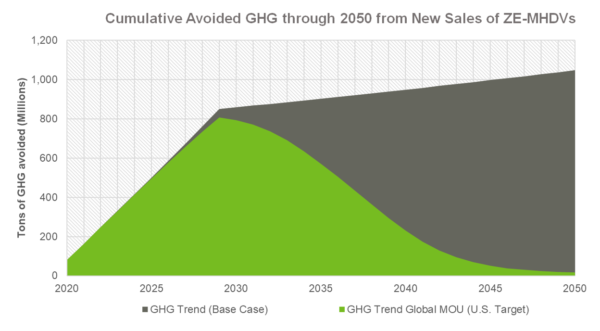The transportation sector continues to be the nation’s largest greenhouse gas (GHG) emitter and a major source of conventional air pollution. We can do better. Now is the time to lean in to the technological innovation that is accelerating at every turn; our climate, our public health, and the growth of our global economy depend on it. Right now, the United States can set a path to avoid 718 million metric tons of greenhouse gas emissions by 2040 in the United States, and 1,030 million metric tons by 2050 by joining the Drive to Zero Memorandum of Understanding (MOU).
Commercial vehicles—trucks and buses—constitute only 4% of the global on-road vehicle fleet but are responsible for roughly 36% of on-road fuel consumption and upward of 73% of NOx emissions. These outsized contributors to pollution are critical to solving the climate crisis. But this can only happen if we embrace the strong policies, programs, and collaboration needed to transform the transportation sector.
The Inflation Reduction Act signed by President Biden this year will accelerate this transportation transition, equalizing the total cost of ownership between zero-emission vehicles and their diesel counterparts 12 years sooner by some estimates.
CALSTART’s Drive to Zero MOU, co-led with the government of the Netherlands as a campaign of the Clean Energy Ministerial, is urging the world’s highest transport emitters to lead from the front and commit to signing the Global MOU, the most ambitious global effort today to address the climate crisis through zero-emission trucks and buses. The Global MOU calls for 30% of new sales of commercial vehicles to be zero-emission by 2030 and a full transition to zero-emission new commercial vehicles by 2040.
Innovative companies around the world are setting ambitious goals for zero-emission transport. As noted in a recent Washington Post article, “Volvo plans to be ‘fossil free’ by 2040 and boasted in its latest annual report that it was ‘leading the transformation’ of the industry. Daimler Truck, the largest maker of heavy trucks globally, has set a goal of selling only carbon-neutral trucks and buses in the United States, Europe and Japan by 2039.”
Twenty-four companies recently sent a letter urging President Biden to sign the MOU to support this transition and build on the investments the Inflation Reduction Act is already bringing.
Zero-emission commercial vehicle technology is ready for most commercial vehicle applications today. Zero-emission trucks are collecting refuse and mail, running freight, delivering packages, and much more all over the world. It will soon be possible to find zero-emission models in all truck applications.¹ Importantly, we have already achieved cost parity for zero-emission trucks and buses in terms of the total cost of ownership in some nations, including the United States. And, by 2030, we will reach cost parity for the vast majority of truck and bus platforms.
As the most recent United Nations report stated, there is no credible pathway to 1.5C in place today, and a large-scale, rapid investment to cut emissions by 45% is urgently needed. The following figure depicts the cumulative GHG emission reductions through 2050 if the United States signs on to the Global MOU. By signing the Global MOU, the United States can support avoiding 718 million metric tons of greenhouse gas emissions by 2040 and 1,030 million metric tons by 2050. 
Source: CALSTART/Baha Al-Alawi and Owen MacDonnell.
Base Case Criteria: all diesel vehicles, life of vehicle is 10 years, fuel economy for diesel fixed at 2020 rates.
The United States can help lead the world in the transformation of our transport systems today by committing to support accelerating zero-emission trucks and buses in collaboration with other like-minded nations. The climate crisis demands immediate action. Let’s seize this opportunity and change transportation for good.
¹Our analysis shows that many big trucks in the two states [CA and NY]— approximately 65 percent of medium-duty trucks and 49 percent of heavy-duty trucks — are regularly driving short enough routes that they could be replaced with electric trucks that are on the market today.

